Do you have a question about the Kenmore 110.2803 Series and is the answer not in the manual?
Explains the benefits and inclusions of the Master Protection Agreement for extended coverage.
Information on professional installation services offered by Sears for home appliances.
Covers defects in material or workmanship for one year from purchase date.
Covers replacement of drum/tub for ten years due to defective material or workmanship.
Lists items and conditions not covered by the warranty, such as expendable items or misuse.
Limits implied warranties and excludes incidental or consequential damages.
Explains the meaning of safety alert symbols (DANGER, WARNING) and their associated hazards.
Provides critical precautions to reduce risks of fire, electric shock, or injury during washer use.
Lists tools and parts required for installation, including optional and alternate parts.
Specifies tools required for securing the drain hose and ensuring the washer is level.
Discusses choosing a suitable location to improve performance and minimize noise.
Provides recommended spacing dimensions for recessed or closet installations.
Details requirements for standpipe drain installation, including diameter and height.
Outlines requirements for laundry tub drain installation, including capacity and height.
Describes floor drain installation, mentioning the need for a siphon break.
Warns about electrical hazards and proper grounding procedures.
Provides detailed instructions for grounding the washer to prevent electric shock.
Advises on safety precautions and initial checks before commencing installation.
Guides on removing shipping materials essential for proper washer operation.
Instructions on how to properly connect the drain hose to prevent floor damage.
Details how to form and connect the drain hose for standpipe or tub drainage.
Provides instructions to ensure proper drainage and prevent backflow.
Notes specific requirements for floor drain installations.
Step-by-step guide to connect the hot and cold water inlet hoses to the washer valves.
Instructions for connecting the inlet hoses to the hot and cold water faucets.
Details how to secure the drain hose using a tie strap to laundry tub or standpipe.
Explains the process of leveling the washer to minimize noise and vibration.
Warns about the weight hazard when moving and leveling the washer.
Verifies correct electrical supply, grounding, and checks for leaks after installation.
Reiterates electrical safety warnings regarding grounding during installation.
Guides on performing an initial test cycle with detergent to clean the washer.
Explains how the washer automatically adjusts water level based on load size.
Describes the electronic control that senses and maintains water temperature for optimal cleaning.
Highlights the convenience of automatic dispensers for detergent, bleach, and softener.
Details the Stain Treat option for enhanced soil and stain removal.
Mentions ease of use with electronic controls and preset cycles.
Notes the use of sound-dampening materials for reduced noise.
Explains components that reduce washer "walk" and "out of balance" conditions.
Describes the corrosion-resistant basket enabling higher spin speeds.
Explains the filtration system that traps and flushes dirt.
Allows users to delay the start of a wash cycle for up to 9 hours.
An audible signal indicating the end of a wash cycle.
A water-saving rinse method used on some cycles.
Provides step-by-step instructions for loading and starting the washer.
Critical safety warning about flammable fluids and oil-soaked items.
Instructions for adding detergent, bleach, and fabric softener to dispensers.
Explains how to pause, add garments, and restart the wash cycle.
How to stop the wash cycle and drain the tub.
How to change settings before or during a wash cycle.
Steps to manually drain the washer and spin the load.
Describes the "Clothes Clean" status light and when it turns off.
Explains the "Lid Lock" status light and when the lid can be opened.
General information about indicator lights showing selected cycles, modifiers, and options.
How the display shows estimated cycle time and factors affecting it.
Explains how to use preset cycle settings and provides a chart with details.
Details the Whitest Whites cycle, including bleach usage and spin speed.
Describes the Heavy Duty cycle for heavily soiled items.
Explains the Normal cycle for everyday loads.
Covers the Casual/Wrinkle Free cycle for no-iron fabrics.
Details the Darks/Colors cycle for dark or heavily dyed fabrics.
Describes the Delicate cycle for lightly soiled or delicate items.
Explains the Ultra Handwash cycle for special care garments.
Provides reasons why garments are labeled "Handwash."
Describes the Drain & Spin cycle for extra draining and spinning.
Explains how to adjust wash time based on soil level.
Details the automatic water level sensing feature.
How to manually adjust water level settings.
Explains ATC's role in sensing and maintaining water temperature.
Notes that detergents work well above 60°F.
Instructions on how to set a delayed start for the wash cycle.
How to adjust the delay time before it starts counting down.
How to cancel a previously set delayed start.
The audible signal that indicates the end of a wash cycle.
Option to ensure proper dispensing of fabric softener.
Option for enhanced cleaning action on tough stains.
Options for set-in stains and soils needing extra treatment.
How to turn the washer on and off.
How to start the wash cycle after selecting settings.
How to pause, stop, or unlock the lid.
Describes sounds that are normal during washing, draining, and spinning.
Recommendations for preparing garments to prolong their life and prevent damage.
Guidelines for sorting clothes based on soil level, color, and fabric type.
Advice on prompt unloading of the washer after cycle completion.
Suggests using options like Stain Treat, Fabric Softener, and 2nd Rinse for enhancements.
Instructions on how to clean the washer interior and exterior.
Advises on replacing inlet hoses every 5 years and periodic inspection.
Guidance on preparing the washer for periods of non-use or moving, including winterizing.
Steps to prepare the washer after winterizing or storage.
Instructions for safely transporting the washer, including winterizing if needed.
Steps for reinstalling the washer after transport.
Explains various error codes displayed by the washer and their meanings.
Addresses common problems with washer components and their operational failures.
Addresses issues related to noise, vibration, and unbalanced loads.
Provides checks for common causes of washer leaks and hose problems.
Guides on diagnosing and resolving issues where the washer fails to fill, rinse, or agitate.
Addresses low water level, overload, and hose kink issues.
Troubleshooting scenarios where the cycle is stuck, continues to fill/drain, or won't drain/spin.
Checks for reversed hoses, temperature variations, and excessive sudsing.
Addresses common causes of residue, lint, and wrinkling on clothes.
Troubleshooting issues with stains, gray whites, dingy colors, and garment damage.
Explains the benefits and inclusions of the Master Protection Agreement for extended coverage.
Information on professional installation services offered by Sears for home appliances.
Covers defects in material or workmanship for one year from purchase date.
Covers replacement of drum/tub for ten years due to defective material or workmanship.
Lists items and conditions not covered by the warranty, such as expendable items or misuse.
Limits implied warranties and excludes incidental or consequential damages.
Explains the meaning of safety alert symbols (DANGER, WARNING) and their associated hazards.
Provides critical precautions to reduce risks of fire, electric shock, or injury during washer use.
Lists tools and parts required for installation, including optional and alternate parts.
Specifies tools required for securing the drain hose and ensuring the washer is level.
Discusses choosing a suitable location to improve performance and minimize noise.
Provides recommended spacing dimensions for recessed or closet installations.
Details requirements for standpipe drain installation, including diameter and height.
Outlines requirements for laundry tub drain installation, including capacity and height.
Describes floor drain installation, mentioning the need for a siphon break.
Warns about electrical hazards and proper grounding procedures.
Provides detailed instructions for grounding the washer to prevent electric shock.
Advises on safety precautions and initial checks before commencing installation.
Guides on removing shipping materials essential for proper washer operation.
Instructions on how to properly connect the drain hose to prevent floor damage.
Details how to form and connect the drain hose for standpipe or tub drainage.
Provides instructions to ensure proper drainage and prevent backflow.
Notes specific requirements for floor drain installations.
Step-by-step guide to connect the hot and cold water inlet hoses to the washer valves.
Instructions for connecting the inlet hoses to the hot and cold water faucets.
Details how to secure the drain hose using a tie strap to laundry tub or standpipe.
Explains the process of leveling the washer to minimize noise and vibration.
Warns about the weight hazard when moving and leveling the washer.
Verifies correct electrical supply, grounding, and checks for leaks after installation.
Reiterates electrical safety warnings regarding grounding during installation.
Guides on performing an initial test cycle with detergent to clean the washer.
Explains how the washer automatically adjusts water level based on load size.
Describes the electronic control that senses and maintains water temperature for optimal cleaning.
Highlights the convenience of automatic dispensers for detergent, bleach, and softener.
Details the Stain Treat option for enhanced soil and stain removal.
Mentions ease of use with electronic controls and preset cycles.
Notes the use of sound-dampening materials for reduced noise.
Explains components that reduce washer "walk" and "out of balance" conditions.
Describes the corrosion-resistant basket enabling higher spin speeds.
Explains the filtration system that traps and flushes dirt.
Allows users to delay the start of a wash cycle for up to 9 hours.
An audible signal indicating the end of a wash cycle.
A water-saving rinse method used on some cycles.
Provides step-by-step instructions for loading and starting the washer.
Critical safety warning about flammable fluids and oil-soaked items.
Instructions for adding detergent, bleach, and fabric softener to dispensers.
Explains how to pause, add garments, and restart the wash cycle.
How to stop the wash cycle and drain the tub.
How to change settings before or during a wash cycle.
Steps to manually drain the washer and spin the load.
Describes the "Clothes Clean" status light and when it turns off.
Explains the "Lid Lock" status light and when the lid can be opened.
General information about indicator lights showing selected cycles, modifiers, and options.
How the display shows estimated cycle time and factors affecting it.
Explains how to use preset cycle settings and provides a chart with details.
Details the Whitest Whites cycle, including bleach usage and spin speed.
Describes the Heavy Duty cycle for heavily soiled items.
Explains the Normal cycle for everyday loads.
Covers the Casual/Wrinkle Free cycle for no-iron fabrics.
Details the Darks/Colors cycle for dark or heavily dyed fabrics.
Describes the Delicate cycle for lightly soiled or delicate items.
Explains the Ultra Handwash cycle for special care garments.
Provides reasons why garments are labeled "Handwash."
Describes the Drain & Spin cycle for extra draining and spinning.
Explains how to adjust wash time based on soil level.
Details the automatic water level sensing feature.
How to manually adjust water level settings.
Explains ATC's role in sensing and maintaining water temperature.
Notes that detergents work well above 60°F.
Instructions on how to set a delayed start for the wash cycle.
How to adjust the delay time before it starts counting down.
How to cancel a previously set delayed start.
The audible signal that indicates the end of a wash cycle.
Option to ensure proper dispensing of fabric softener.
Option for enhanced cleaning action on tough stains.
Options for set-in stains and soils needing extra treatment.
How to turn the washer on and off.
How to start the wash cycle after selecting settings.
How to pause, stop, or unlock the lid.
Describes sounds that are normal during washing, draining, and spinning.
Recommendations for preparing garments to prolong their life and prevent damage.
Guidelines for sorting clothes based on soil level, color, and fabric type.
Advice on prompt unloading of the washer after cycle completion.
Suggests using options like Stain Treat, Fabric Softener, and 2nd Rinse for enhancements.
Instructions on how to clean the washer interior and exterior.
Advises on replacing inlet hoses every 5 years and periodic inspection.
Guidance on preparing the washer for periods of non-use or moving, including winterizing.
Steps to prepare the washer after winterizing or storage.
Instructions for safely transporting the washer, including winterizing if needed.
Steps for reinstalling the washer after transport.
Explains various error codes displayed by the washer and their meanings.
Addresses common problems with washer components and their operational failures.
Addresses issues related to noise, vibration, and unbalanced loads.
Provides checks for common causes of washer leaks and hose problems.
Guides on diagnosing and resolving issues where the washer fails to fill, rinse, or agitate.
Addresses low water level, overload, and hose kink issues.
Troubleshooting scenarios where the cycle is stuck, continues to fill/drain, or won't drain/spin.
Checks for reversed hoses, temperature variations, and excessive sudsing.
Addresses common causes of residue, lint, and wrinkling on clothes.
Troubleshooting issues with stains, gray whites, dingy colors, and garment damage.
| Brand | Kenmore |
|---|---|
| Model Number | 110.2803 Series |
| Type | Top Load Washer |
| Agitator | Yes |
| Energy Star | No |
| Color | White |
| Voltage | 120 V |
| Warranty | 1 year limited |
| Depth | 27 inches |
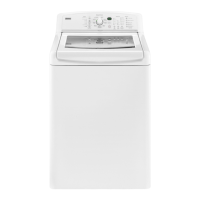
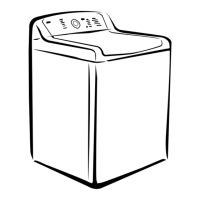


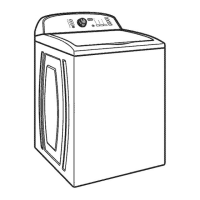
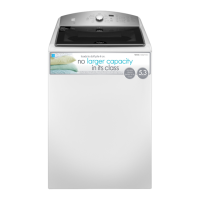





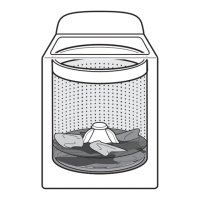
